|
Electrical Equipment
Manufacturers |
William Sanders &
Company. Electrical Switchgear and Fuses
William Sanders & Company started in 1894 and
transferred to a small factory in Ridding Lane in
1897, occupying a small corner of the site. The firm
got off to an unfortunate start, as reported in
volume 50 of the Electrical Review, April 11th 1902.
Lewis Bayliss & Company, an electrical accessories
manufacturer of Ridding Lane, in partnership with F.
Terrill & Company at Brunswick Park Road, had been
declared bankrupt. The firm also carried on business
at 110 Cannon Street, London, under the name
Cordwell & Company, and also as the Thames
Electrical Manufacturing Company at 1 and 2
Bucklersbury, also in London.
The businesses were all run by 25 years old Lewis
Bayliss, who had debts amounting to £2,273. It was
stated by the official receiver, that Mr. Bayliss,
who began as a cycle and electrical accessories
manufacturer in Walsall Street, Wednesbury, had
taken over other businesses, with insufficient
capital, and mismanaged them. He also stated that
Lewis Bayliss & Company of Ridding Lane, were only
involved as creditors in the bankruptcy proceedings.
The proprietor of Lewis Bayliss & Company was
William Sanders, who then carried on the business at
Ridding Lane, under his own name.
In 1907 William Preston married Lilly Swinton
Sanders, and became managing director of William
Sanders & Company. He was educated at Walsall
Grammar School and Weston School, Bath and played
cricket for Staffordshire in the Minor Counties
Championship.
|
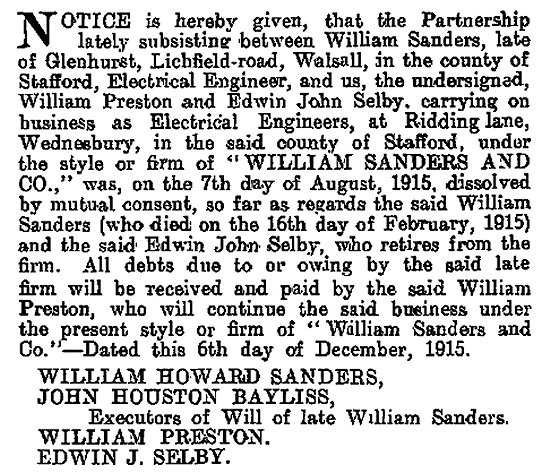 |
A notice from the
London Gazette. 10th December, 1915. |
|
William Sanders, who lived at Glenhurst,
Lichfield Road, Walsall, died on the 16th February,
1915. After his death, William Preston, ran the
business.
In the 1924 general election, William Preston was
chosen as Conservative candidate for the Walsall
constituency, and unseated the sitting Liberal MP,
Pat Collins.
Following
the election it was discovered that Preston had
received payments for two small contracts to supply
electrical fittings to the Post Office Stores
Department. As a government contractor he was
ineligible to stand for parliament, and so he had to
stand down.
He overcame the legal difficulties and was
selected as Conservative candidate at the following
by-election in 1925. Again he was successful and
became a member of parliament.
It only lasted for one term because in the 1929
general election he was defeated by the Labour
candidate. He then retired from politics.
William Sanders of Ridding Lane, became a limited
company in 1934 and a public company in 1951.
|
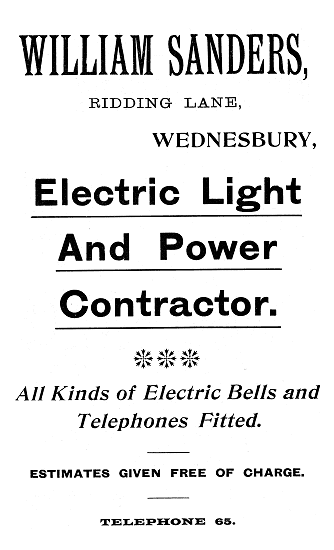
An advert from 1905. |
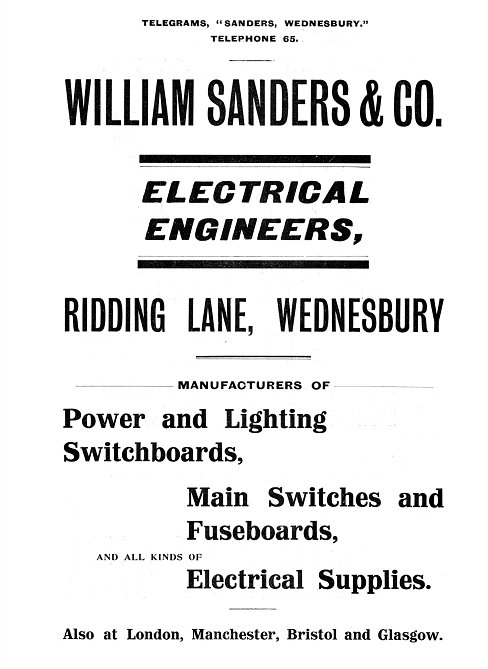 |
An advert from 1909. |
|

William Preston. |
William Preston died at the age of 67 at
his home, Byelanes, Gorway Road, Walsall, in
November 1941 after a long illness. His nephew, one of the best known Wednesbury
personalities, was Richard Wattis, who started work
at William Sanders & Company after leaving school.
He stayed with the firm for several years until his
acting career began in the mid 1930s.
|
|

An advert from
'Electricity' 12th November, 1926. |
|
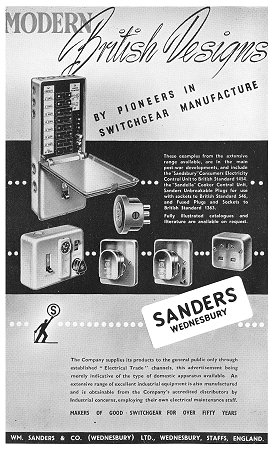
An advert from 1949. |
Falcon Electrical Works grew to cover a large area
and during its latter years became known as the Ottermill.
The company
manufactured electrical switchgear and fuse gear to a
high standard and undertook a lot of pioneering design
work in this field.
Switched fuse boxes were produced, ranging from
small domestic versions to large 3 phase units for
industrial use.
One of the company's specialities was 3
phase, high current switchgear, much of which must still
be in use.
Sanders also produced fused plugs, 13 amp
sockets, with or without a switch, fuse holders, and
fuses. |
|
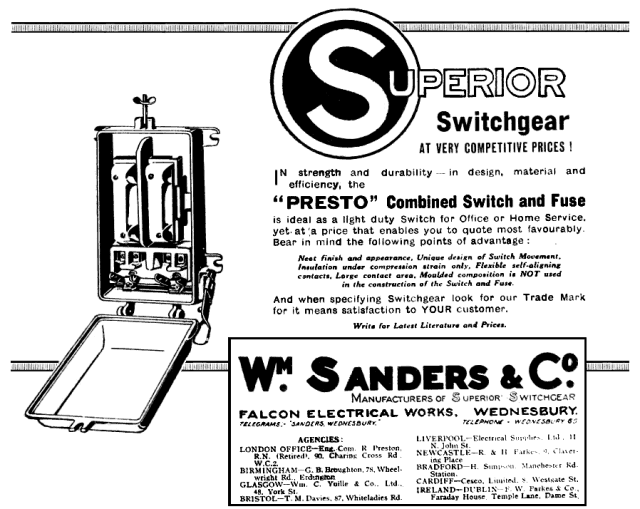
An advert from 1922. |
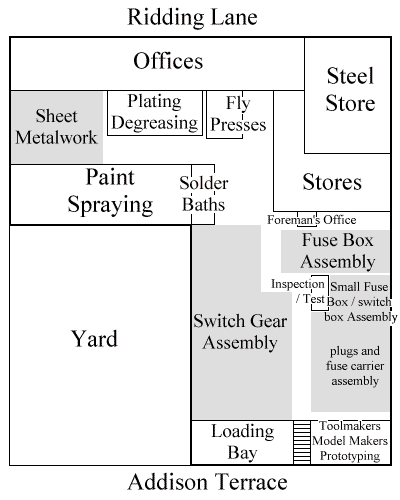 |
|
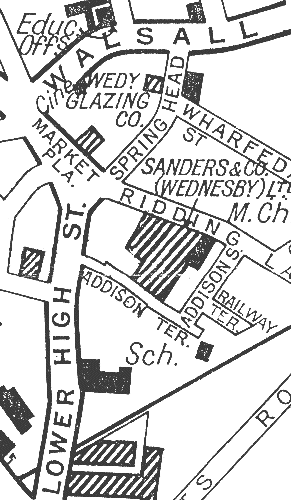 |
|
The
layout of the factory. |
|
The
location of the factory. |
|
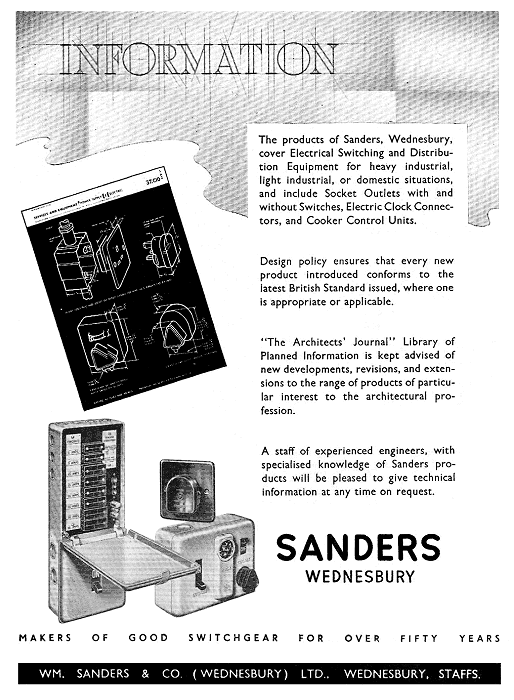 |
An advert from 1950. |
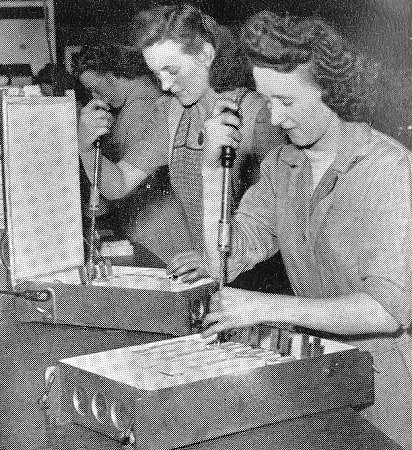
Assembling 'Sandamax' fused switch boxes.

Assembling large fuse carriers, in the
general assembly area.
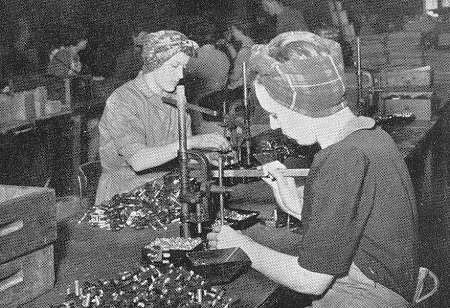
Assembling unbreakable plugs.
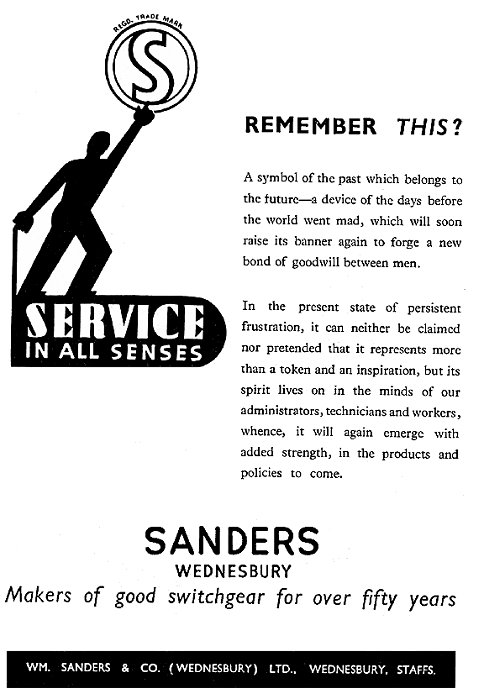
An advert from April 1947.
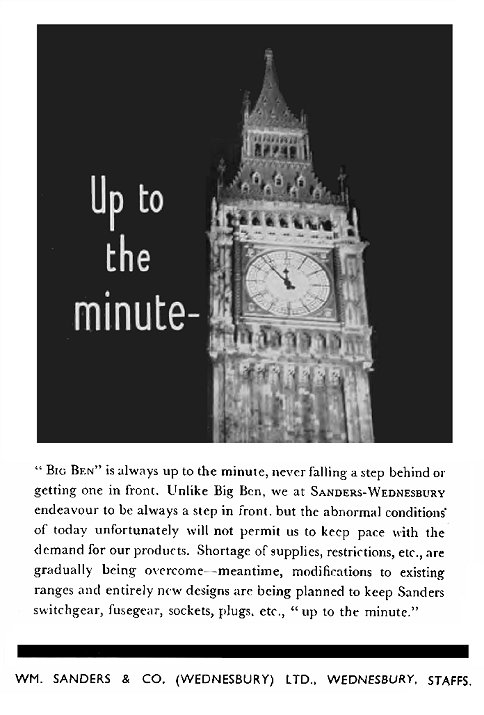
An advert from November 1946.
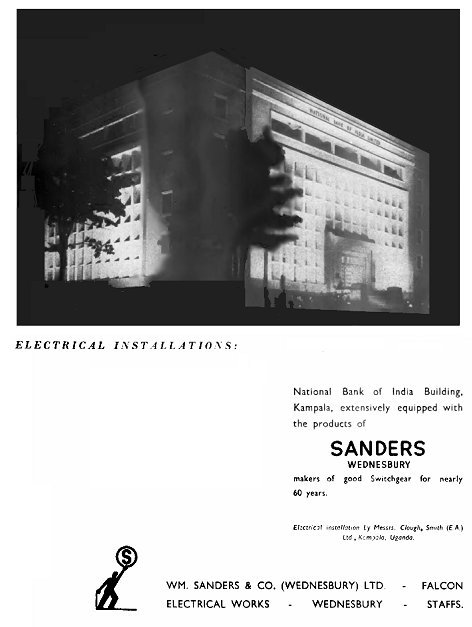
An advert from November 1954.

An advert from November 1955.
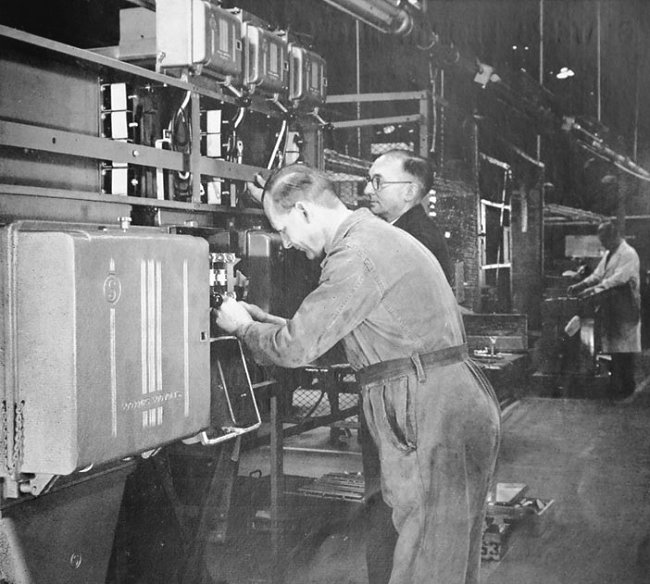
Building switchgear in 1961. In the
centre, wearing glasses is Ted Maybury.
|
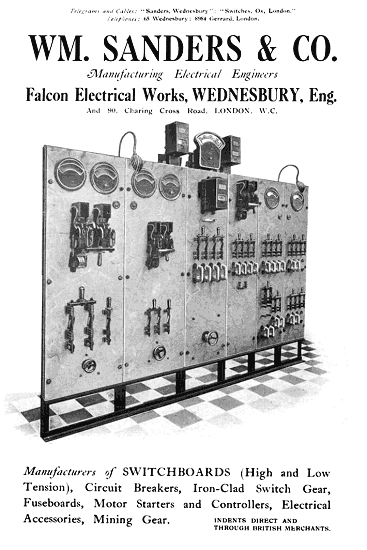
An advert from 1916. |
|
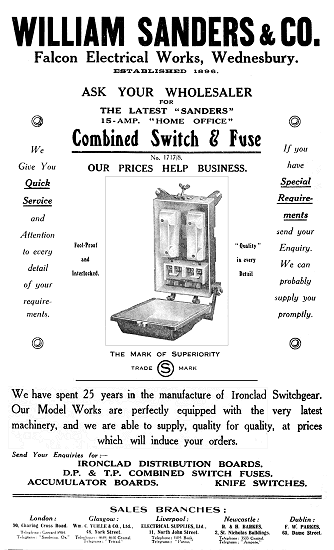
An advert from 1921. |
 |
A Sandamax switched fuse
box that demonstrates the reliability of Sanders'
products. It was in
use until May 2023 after working from new in a
railway turntable in Christchurch, New Zealand.
Courtesy of Jeff Teasdale,
electrical inspector. |
| Other products included the 'Sandsbury' consumer
unit, the 'Sandella' cooker control unit, and
unbreakable 13 amp plugs. The company's switchgear was
available in small, standard, off the shelf units, or
for large installations which were designed to meet
individual customer's requirements. A large section of
the factory was devoted to the assembly of made-to-order
switchgear, for installations of all sizes and types. Most of the components such as cases, busbars, switches,
and contacts were made in the factory, where every item
was thoroughly inspected and tested before leaving. All
design and development was carried out on the site,
including the building of prototype products by an
expert model maker. |
 |
 |
From the Electrical
Review, 27th July, 1945. |
|
Sanders took out many patents during the company's
lifetime, some of which were developed by Ernest Bayley
Manion. His designs were put into practice by Irwin
Palmer, Chief Draughtsman and Designer. The list of patents included the following:
|
Date |
|
Brief description |
|
Feb. 10th |
1936 |
|
The insertion of an
earth-pin into a switch plug in which an arm
is displaced by the earth pin to uncover the
current-carrying socket tubes. |
|
Mar. 30th |
1936 |
|
Improvements in and
relating to quick make and break electric
switches. |
|
Sep. 25th |
1936 |
|
Improvements in and
relating to three pin plug-in electric
switches. |
|
Mar. 25th |
1937 |
|
Improvements relating to
combined plug couplings and electric
switches. |
|
May 6th
|
1937 |
|
Improvements in and
relating to interlocking electric switch
plugs. |
|
Feb. 13th |
1946 |
|
Fusible cut-outs, and
combined clip and contact making for a
cartridge fuse. |
|
May 1st
|
1946 |
|
Two-part couplings combined
with fuses. |
|
May 17th |
1946 |
|
A lamp-holder with a
laminated base and domed contacts connected
by metal strips. |
|
May 14th |
1948 |
|
Improvements relating to
holders for cartridge link fuses. |
|
Oct. 29th |
1948 |
|
Improvements relating to
electrical fused plugs. |
|
Nov. 9th
|
1948 |
|
Improvements relating to
holders for electric lamps. |
|
Mar. 19th |
1952 |
|
Improvements relating to
means of connecting together electric
cables. |
|
Aug. 20th |
1952 |
|
Improvements relating to
electrical fuses. |
|
Oct. 15th |
1952 |
|
Improvements relating to
fuse carriers for electric fuse-links of the
cartridge type. |
|
| |
|
| View some Sanders' products
from the 1950s and 1960s. |
 |
| |
|
|
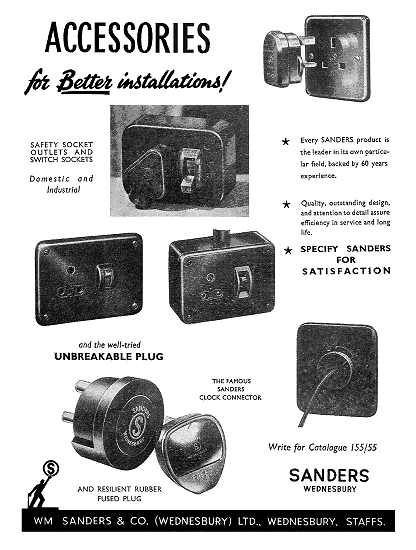
An advert from 1956. |
Many of the products were exported all over the
world and the relationship between management and
employees was always good, with a warm and friendly
atmosphere prevailing at the works. Some of the seventy or so people employed in the
factory in the late 1960s included Norman Martin who was
in charge of the stores, storekeeper David James,
assembly foreman Ted Moylan, and switchgear foreman Sid
Smith.
Ronnie Mann inspected and flash tested
completed fuse boards, switch fuses and switchgear, and
Mrs. Culpeck ran the personnel department in the office.
I must thank John Harrison who worked in the
factory, for most of the above names. |
| I must also thank Harry Edge, who
worked for the company between 1956 and
1962, mainly in the drawing office, and
the quotations department. Harry has
kindly supplied the following
information: Irwin Palmer was Chief
Draughtsman and Designer. Switchboards
were designed by Basil Dodd from
Bilston, assisted by Detail Draughtsmen
- Basil Cope, Bernard Minton and Harry
Edge. Ted Canto, ex Royal Navy, was in
charge of sales, Bill Heywood was sales
office manager, and quotations
were looked after by Ray "Dave" Goodman,
also ex Royal Navy. Jack Prescott
looked after buying and costing, with
the assistance of Jack Hollinshead, and
the whole site was maintained by Arthur
Davies, the Works Engineer. Reg
Nicholls, one of the Directors was an
accomplished violinist who had
associations with Darlaston operatics.
He was also a keen Mason. Harry had to
produce table plans in ink, on linen,
for various masonic functions.
Part of the stores was located
underground. It was reputed to have been
the safest place in the town during air
raids. Every year there was a free
staff dinner and dance at Darlaston Town
Hall.
Harry also mentioned that type 'A'
switchboards, flush fuse switches in a
sheet steel enclosure, were commonly
known as "Cubicle Switchboards" and that
fuse switches, known as 'Sandaclad' had
High Rupturing Capacity fuse links (H.R.C.)
carried on the moving part of the
mechanism, effecting a complete double
break. Also switchfuses, known as 'Sandamax'
had stationary fuse holders. The blades
of the switch moved onto them. |
|
The company became
part of the Ottermill Group, a subsidiary of the
Westinghouse Electric Corporation. Over the next few years the operation at Wednesbury
was transferred to the Ottermill Group's factory at
Hungerford, Berkshire called Ottermill Chilton. The
Chilton factory, built in 1959 was taken over by
Westinghouse in the mid 1970s.
On 12th December,
1977 an official receiver was appointed to wind-up the
business at Wednesbury. The business address of the receiver
Paul Reeve, is the registered office of the Ottermill
Group, as can be seen from this notice in the edition of
The London Gazette, dated 29th December, 1977:
Name of Company: Sanders Switchgear Limited.
Nature of Business: Manufacturers of electrical
machinery and apparatus.
Address of Registered Office: Falcon Electrical
Works, Ridding Lane, Wednesbury, West Midlands.
Liquidator's Name and Address: Paul Reeve, The
Otter Mill, Ottery St. Mary, Devon, EX11 1AG.
Date of Appointment: 12th December 1977.
The other businesses in the group that went into
receivership at the same time were:
Chilton Electric Products Ltd.,
Church Way, Hungerford, Berkshire.
Ottermill Telio Limited, Aysgarth Road, Waterlooville,
Hampshire.
Prentice Limited, Falcon Electric Works, Ridding Lane,
Wednesbury. |
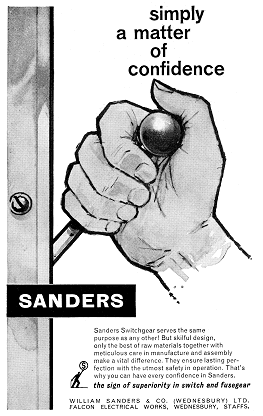
An advert from the early 1960s. |
| A further notice appeared in The London Gazette on
13th February, 1978: |
|
Sanders Switchgear Limited
Notice is hereby given, pursuant
to Sections 300 and 341 of the Companies Act
1948, that a Meeting of the Creditors of the
Company will be held at The Otter Mill, Ottery
St. Mary, Devon on the 17th March 1978 at 10 am
for the purpose of having an account laid before
the creditors showing the manner in which the
winding up has been conducted and the property
of the Company disposed of, and of hearing any
explanation that may be given by the Liquidator,
and also of directing the manner in which the
books, accounts and documents of the Company and
of the Liquidator shall be disposed of.
Dated the 6th February 1978.
P. Reeve, Liquidator. |
|
|

From a 1976 edition of Hungerford
Festival News. |
Many
members of the Wednesbury staff were offered jobs at
Hungerford and relocated there. They must have expected
to be moving to secure jobs, especially as they were now
working for Westinghouse, a massive organisation. Falcon
Electrical Works closed in the early 1980s and was
demolished in September 1987 to make way for the houses
in Ridding Lane, Addison Terrace and Gregory Close.
The Ottermill Group specialised in the design,
manufacture and supply of medium voltage electrical
distribution and control equipment, ranging from
industrial switchboards and control panels, to products
for the domestic market. Items made at the Hungerford
factory carried the Chilton brand name.
Sadly the new jobs and promised stability at
Hungerford for the ex-Wednesbury workers was short
lived. In the mid 1980s Westinghouse transferred all
production at Hungerford to Ireland, and the factory
closed in November 1985.
The Hungerford factory suffered the same fate as
Falcon Electrical Works. After closure the site was sold
for housing, and is now occupied by the houses in Cherry
Grove. |
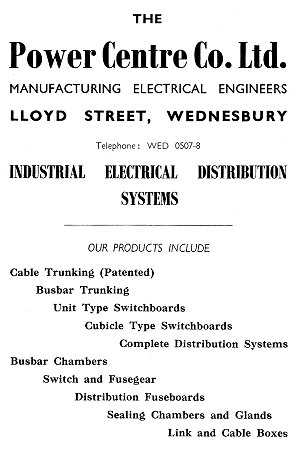
The Power Centre Co. Ltd.,
Wednesbury's other major manufacturer of all kinds of
electrical power equipment. |
|
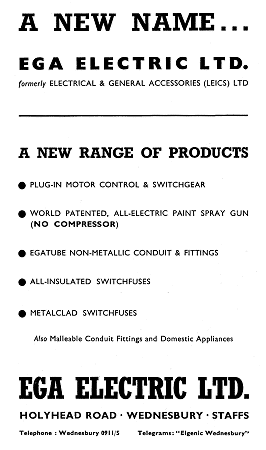
Another electrical manufacturing
company, which moved to the town from Leicester in the
late 1940s. |
|
The Power
Centre. Electrical Trunking
The Power Centre Company Limited
was founded in 1901 at 11 Chaloner Street, Liverpool. In
1937 the firm exhibited a range of products at the
British Industries Fair, including a busbar trunking
system, a cable trunking system, switchgear, control
gear, and accessories. There was great demand for the
company's products, and so the business moved to larger
premises at Wednesbury
in 1938 on the corner of Lloyd Street and Meeting
Street, where the firm manufactured busbar trunking, cable
trunking and electrical distribution equipment.
|
|
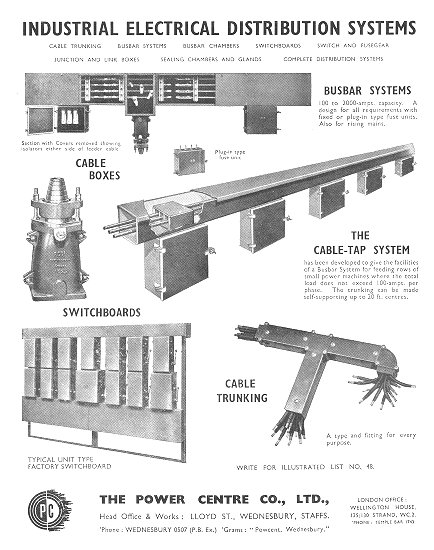
An advert from 1954. |
The Wednesbury factory was greatly
enlarged, in order to keep-up with the ever-growing
demand for the company's products. In 1949 a second
factory was built in Walsall to specialise in the
construction of switchgear and fuse boxes.
The company claimed to have
produced the first complete busbar trunking system, the
first cable trunking system, and took out many patents
including a system for supporting electrical conductors,
and a flameproof turret cable trunking system suitable
for underfloor use.
In 1958 another factory was opened in Elwell
Street, which included some of the most up-to-date
plant. In the 1960s the firm introduced an economical
system for distributing electricity for lighting and
power appliances in workshops and garages called
'Plug-Line'. It used pre-wired cable trunking two inches
square, which came complete with socket outlets for
overhead or wall mounting.
|
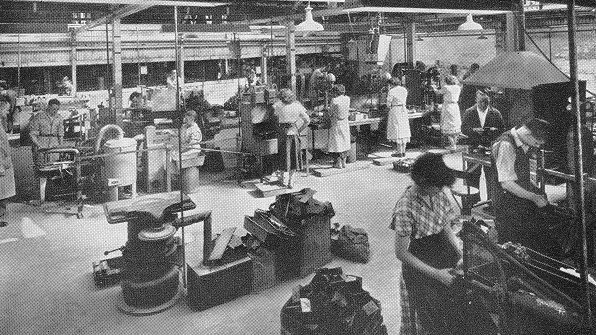
Producing components in the machine shop.
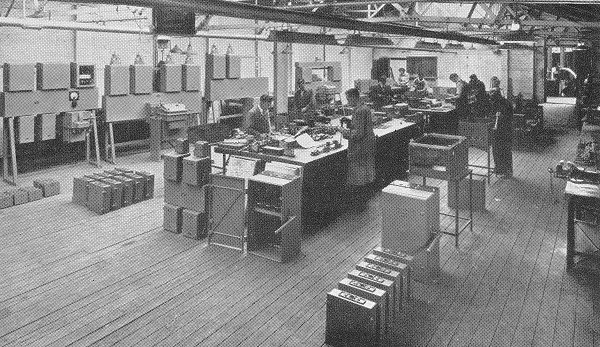
Assembling switchgear and fusegear.
| In 1956 the firm became a
member of the Electrical Division of Tube Investments
Limited, and its products were distributed through the
branches of the Simplex Electric Company Limited.
The site of the Lloyd Street factory is now occupied
by housing. |
| If anyone can add to what's already here, please
email the
webmaster, who will be delighted to hear from
you. |
|
 |
Return to the
previous page |
|